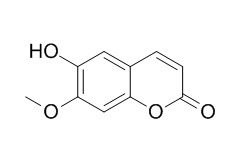Isoscopoletin
Isoscopoletin possesses inhibitory activity against hepatitis B virus (HBV) replication; it also shows substantial inhibition against multi-drug resistant CEM/ADR5000 cells and human CCRF-CEM leukaemia cells, with the IC50 value is 1.6 and 4.0 microM, respectively.
Inquire / Order:
manager@chemfaces.com
Technical Inquiries:
service@chemfaces.com
Tel:
+86-27-84237783
Fax:
+86-27-84254680
Address:
1 Building, No. 83, CheCheng Rd., Wuhan Economic and Technological Development Zone, Wuhan, Hubei 430056, PRC
Providing storage is as stated on the product vial and the vial is kept tightly sealed, the product can be stored for up to
24 months(2-8C).
Wherever possible, you should prepare and use solutions on the same day. However, if you need to make up stock solutions in advance, we recommend that you store the solution as aliquots in tightly sealed vials at -20C. Generally, these will be useable for up to two weeks. Before use, and prior to opening the vial we recommend that you allow your product to equilibrate to room temperature for at least 1 hour.
Need more advice on solubility, usage and handling? Please email to: service@chemfaces.com
The packaging of the product may have turned upside down during transportation, resulting in the natural compounds adhering to the neck or cap of the vial. take the vial out of its packaging and gently shake to let the compounds fall to the bottom of the vial. for liquid products, centrifuge at 200-500 RPM to gather the liquid at the bottom of the vial. try to avoid loss or contamination during handling.
Phytochemistry.2024, 222:114102.
Int Immunopharmacol.2022, 106:108603.
VNU J Science: Med.&Pharm. Sci.2024.2588-1132
Regul Toxicol Pharmacol.2024, 149:105620.
J Drug Delivery Science and Tech.2022, 67:102957.
Cell.2022, 185(23):4298-4316.e21.
J Ethnopharmacol.2018, 210:88-94
Biosci. Rep.2020, 10.1024
Preprints2021, doi:10.20944
Sci Rep.2016, 6:25094
Related and Featured Products
Planta Med. 2006 Jul;72(9):862-4.
Activity-guided isolation of scopoletin and isoscopoletin, the inhibitory active principles towards CCRF-CEM leukaemia cells and multi-drug resistant CEM/ADR5000 cells, from Artemisia argyi.[Pubmed:
16881019]
METHODS AND RESULTS:
The ethyl acetate extract of Artemisia argyi leaves showed substantial inhibition in a cell proliferation assay using human CCRF-CEM leukaemia cells. Bioassay-guided fractionation of the extract led to the isolation of scopoletin and Isoscopoletin as the active principles. Their IC50 values were 2.6 and 4.0 microM, respectively. Additionally the two substances were tested against the multidrug resistant subline, CEM/ADR5000 where they both showed IC50 values of 1.6 microM.
CONCLUSIONS:
In contrast to the standard cytostatic drugs doxorubicin, vincristine, and paclitaxel, CEM/ADR5000 cells therefore did not exhibit cross-resistance to scopoletin and Isoscopoletin.
Planta Med. 2005 Dec;71(12):1128-33.
Evaluation of antiviral activity of compounds isolated from Ranunculus sieboldii and Ranunculus sceleratus.[Pubmed:
16395649 ]
METHODS AND RESULTS:
Nineteen compounds isolated from Ranunculus sieboldii and Ranunculus sceleratus were tested for inhibitory effects on hepatitis B virus (HBV) and Herpes simplex virus type-1 (HSV-1). The results showed that apigenin 4'- O- alpha-rhamnopyranoside, apigenin 7- O- beta-glucopyranosyl-4'- O- alpha-rhamnopyranoside, tricin 7- O- beta-glucopyranoside, tricin, and Isoscopoletin possessed inhibitory activity against HBV replication. Protocatechuyl aldehyde exhibited an inhibiting activity on HSV-1 replication.
CONCLUSIONS:
It is therefore suggested that further investigations on these bioactive compounds might be needed to discover and develop new antiviral agents.
Nat Prod Res. 2013;27(17):1542-7.
Machilusmarin, a new neuroprotective isocoumarin dimer from the stems of Machilus ichangensis Rehd. et Wils.[Pubmed:
23082968 ]
A new isocoumarin dimer, Machilusmarin (1), was isolated from the stem of Machilus ichangensis Rehd. et Wils., together with two known coumarins, scopoletin (2) and Isoscopoletin (3).
METHODS AND RESULTS:
The structure of Machilusmarin (1) was elucidated by HRMS and NMR spectrums. Machilusmarin (1) showed significant neuroprotective activity against SH-SY5Y human neuroblastoma cells apoptosis induced by hydrogen peroxide at concentrations ranging from 0.625 to 10.0 μg mL(-1).



